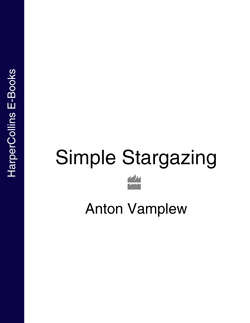Читать книгу Simple Stargazing - Anton Vamplew - Страница 14
Northerly humans start here
ОглавлениеJust look at the page opposite: it’s covered in what looks like a chaotic pattern of differently sized dots. Nothing could be further from the truth. Each dot is actually a star we can see in the night sky and, just like many things that look like chaos to start with, there’s order within this mess.
Lurking within these dots you will find a very useful pattern that is probably the best place to start your stargazing quest in the northern hemisphere. This group is known affectionately as the Plough – well, it is in Britain. Moving around our planet, we find that the Plough is called Karlsvogna (Carl’s Wagon) in Norway, the Big Dipper in the USA and the Saucepan in parts of France. This is definitely a good name for the shape, as you can see – a pan with a handle stretching out to the left. Anyone for space beans?
Now, the Plough is not actually a constellation itself, but part of a much larger group called Ursa Major, the Great Bear – we shall meet it very shortly.
The Plough is always visible from mid-northern latitudes if the skies are dark and the weather crisp and even. Also, all of its seven stars are quite bright, making it an easy group to find. In order to know which direction to look to find The Plough, you need to have some idea of north, south, east and west. As I said a moment ago, the Sun sets in the west(ish), so look to the right of that and up a bit (that’s a technical term) and there’s the Plough in the north(ish). Easy.
It’s not long before patterns begin to emerge from the ether. Ether is an old term for the stuff that scientists used to believe filled space – it doesn’t exist, but the idea’s nice.
Round and round the Plough goes. If you are far enough into the northern hemisphere, this is where you’ll find it at 8 p.m.(ish) at certain times through the year. The left of the diagram is the direction of northwest, whilst the right is northeast.
Because the Earth is constantly turning, don’t expect the Plough to stay in the same place for long. There’s also our movement around the Sun to consider, which means that each night at the same time the Plough will be in a slightly different position. How exciting is that!? Generally you’ll find the Plough higher in the sky during spring and summer evenings, and nearer the horizon in autumn and winter evenings.
As you may have noticed, there is a well-known star ‘locked’ in the centre of the image that the Plough rotates around. This is Polaris, also known as the North Star, or indeed the Pole Star. This last name means that it is the closest star to the North (Celestial) Pole, but because of the way the Earth spins on its axis, this is a temporary title and has been held over millennia by a number of the stars featured in this book.
You can always find Polaris by using the two right-hand stars of the Plough, which are called the Pointers. No need for Sherlock Holmes here – these two stars, Dubhe and Merak, simply ‘point’ up out of the ‘saucepan’ to Polaris. Elementary. And this is just one reason why the Plough is so useful. Through this book you’ll find plenty of ways that it can be used as a ‘signpost’ to many other stars and constellations.
The Pointers of The Plough doing their ‘pointing’ thing.
Polaris is the leading (main) star of Ursa Minor, the Little Bear.
Now, to break a myth: the North Star is not the brightest star in the night sky. It seems that for some unknown reason someone, somewhere, sometime told us that not only was it the brightest but it was also the first star you could see when it got dark. This is not true: Polaris happens to be only the 50th brightest star in our skies. Its fame is due to its position: almost directly above the North Pole. As the Earth spins we see the effect as the sky spinning, and in the northern hemisphere it’s Polaris that everything goes around. Being almost stationary in the sky means that if you’re looking at it you are looking north. And if you know where north is, you also know where east, south and west are. This is why Polaris was great in the olden days when mariners would ‘sail by the stars’.
There’s another group that can be found with supernoval ease by carrying on the line from the Pointers through Polaris to a ‘W’ shape that is Cassiopeia, the Queen. If your house/flat/hut/cave/tent/treehouse, etc. is in a position where the Plough never sets, then neither does Cassiopeia – they’ll both be up, somewhere. Because they are on opposite sides of Polaris, when the Plough is high, Cassiopeia is low and vice versa.
Following imaginary lines made by stars can lead you anywhere in the Universe.
Cassiopeia, the Queen, sits and ponders: ‘Hmmm, I know I’ve forgotten something?’
